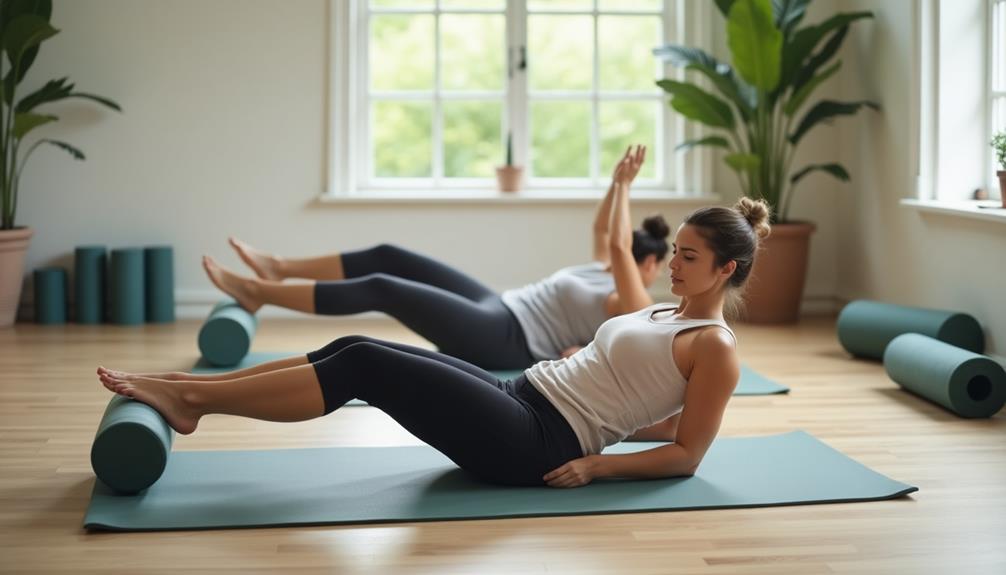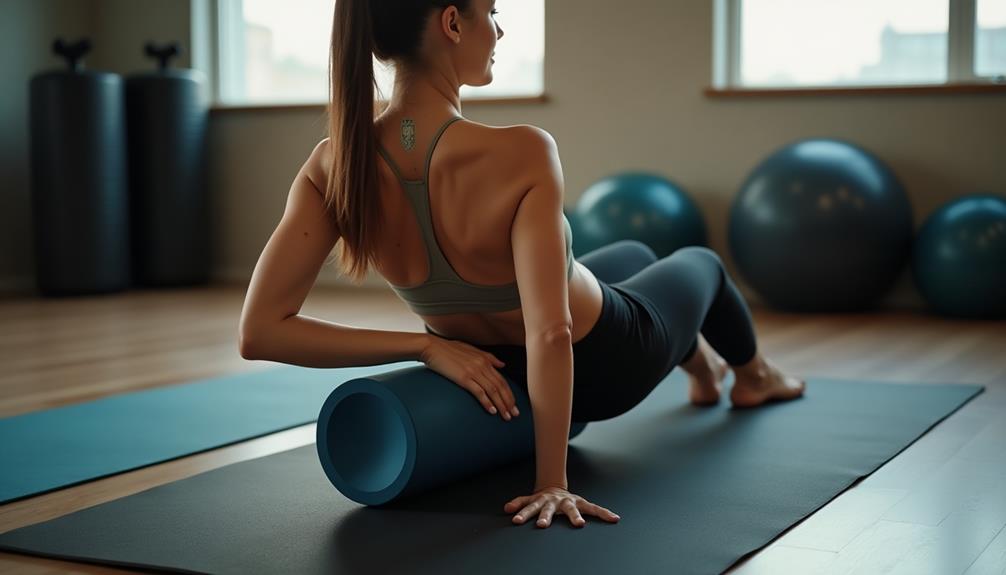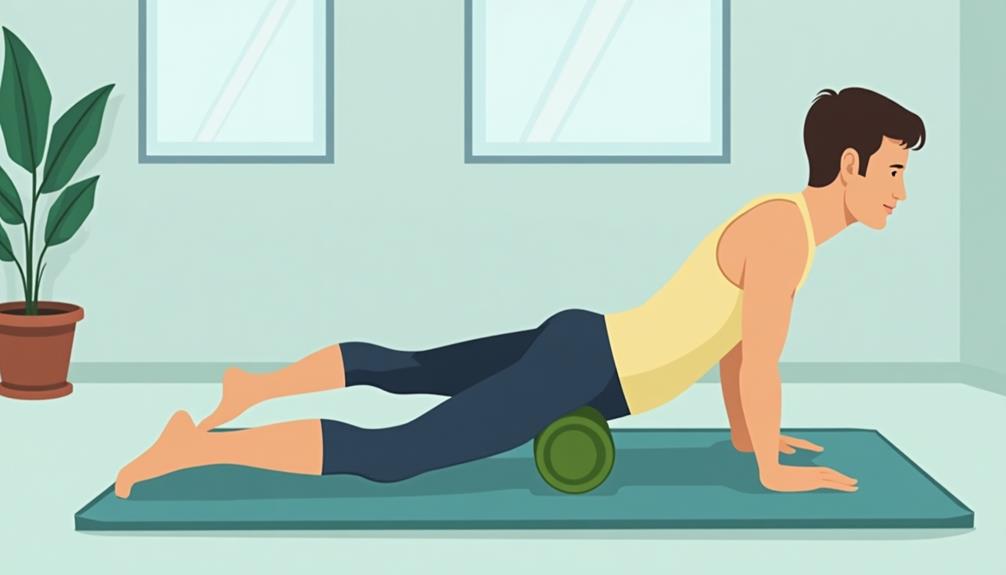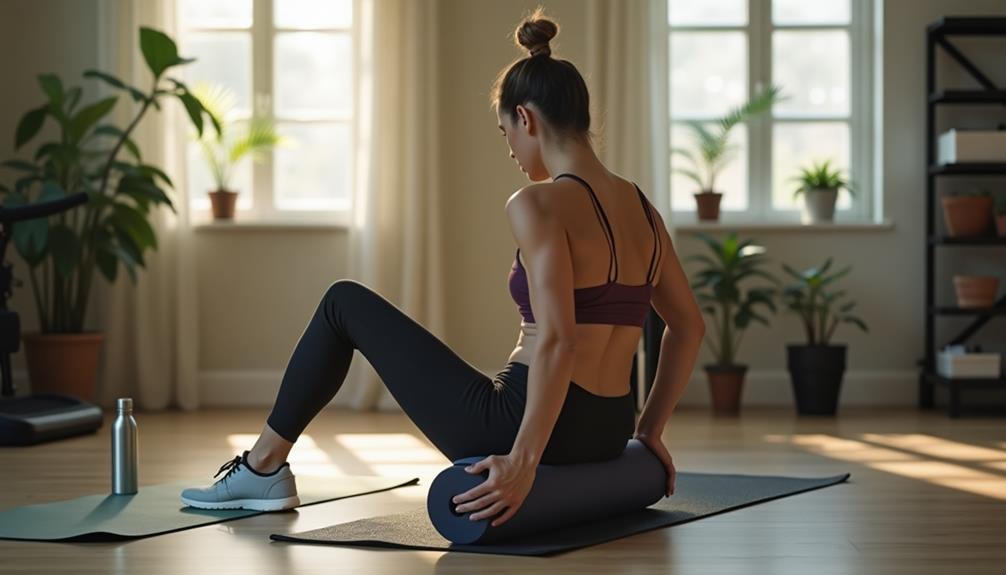Mastering foam rolling is essential for effective recovery. Start by choosing the right foam roller; opt for a softer one if you're a beginner, then progress to firmer types for deeper pressure. Prepare your body with light activity and a positive mindset. When rolling, position the roller under the targeted muscle and use your body weight to apply pressure, rolling slowly to focus on tight areas. Key muscle groups include calves, quads, hamstrings, back, and glutes. Consistently incorporating these techniques into your routine can enhance flexibility and reduce muscle soreness, and there's more to explore for maximizing your recovery.
Core Insights
- Begin with a warm-up to prepare your muscles for effective foam rolling and enhance recovery.
- Choose the appropriate foam roller density based on your experience level and desired pressure.
- Use slow, controlled movements, rolling at about one inch per second to target tight spots effectively.
- Focus on key muscle groups like calves, quads, hamstrings, back, and glutes for comprehensive recovery.
- Maintain a relaxed breathing pattern to help release tension and maximize the benefits of foam rolling.
Understanding Foam Rolling

Why should you consider foam rolling as part of your fitness routine? Foam rolling helps alleviate muscle soreness and improve mobility. It's a self-myofascial release technique that targets knots and tight spots in your muscles. By applying pressure with a foam roller, you increase blood flow to the area, promoting recovery and reducing tension. This practice can enhance your flexibility and range of motion, making it easier to perform exercises effectively. Additionally, foam rolling can help prevent injuries by keeping your muscles supple. Integrating it into your routine can lead to better performance and quicker recovery after workouts. So, whether you're a seasoned athlete or just starting, foam rolling offers significant benefits for your overall fitness journey.
Choosing the Right Foam Roller

When it comes to selecting the perfect foam roller for your needs, understanding the options available can make all the difference. Foam rollers come in various densities and sizes. If you're new to foam rolling, consider starting with a softer roller. It'll be gentler on your muscles. As you gain experience, you might want to switch to a firmer roller for deeper pressure. Just like cooling towels, foam rollers can provide comfort during various activities and aid in recovery. The material composition of your roller can impact its performance and durability.
Additionally, think about the size. A longer roller is great for larger muscle groups, while shorter ones are more portable and easier to target smaller areas. Some rollers also feature textured surfaces for enhanced massage effects. Ultimately, choose a foam roller that aligns with your goals and comfort level. This way, you'll maximize the benefits of your recovery routine.
Preparing for Foam Rolling

Before you start foam rolling, it's pivotal to prepare your body to maximize the benefits and minimize discomfort. Begin by warming up with light activity, like a brisk walk or dynamic stretches. This increases blood flow to your muscles and gets them ready for rolling. Consider selecting a high-density foam roller for deep tissue massage and muscle knot relief. These rollers often feature textured surfaces for enhanced blood flow and targeted pressure.
Next, find a quiet space where you can focus without distractions. Gather your foam roller and any other tools you might need, like a yoga mat or towel for comfort.
Lastly, set a positive mindset. Foam rolling can be intense, but reminding yourself of its benefits helps you stay committed. Take a few deep breaths before you start; this helps you relax and prepares your body for the session ahead.
Effective Foam Rolling Techniques

Effective foam rolling techniques can greatly enhance your recovery and performance. Start by finding a comfortable surface where you can roll freely. Position the foam roller under the targeted area, using your body weight to apply pressure. Roll slowly, allowing the foam to sink into your muscles. Aim for a speed of about one inch per second for best effectiveness. For deep tissue massage and enhanced flexibility, consider using a textured foam roller that mimics the hands of a massage therapist.
Focus on areas that feel tight or sore, pausing for a few seconds on particularly sensitive spots. Maintain a steady breathing pattern to help relax your muscles. Remember to adjust your body position to target different angles, ensuring a thorough release. Incorporate foam rolling into your routine regularly, ideally after workouts, to maximize its benefits and enhance your overall mobility.
Targeting Key Muscle Groups

Targeting key muscle groups is essential for maximizing the benefits of foam rolling. Start with your calves, as they often hold tightness from daily activities. Position the foam roller under your calf and gently roll back and forth. Next, focus on your quads. Lie face down and place the roller under your thighs, rolling slowly to release tension. Don't forget your hamstrings; sit with the roller under your thighs and lean back slightly. Move to your back by placing the roller beneath your shoulder blades and rolling side to side. Finally, target your glutes by sitting on the roller, crossing one ankle over the opposite knee, and shifting your weight. This approach will enhance recovery and improve flexibility.
Incorporating Foam Rolling Into Your Routine

Incorporating foam rolling into your routine can greatly enhance your overall performance and recovery. Start with a few minutes of foam rolling before your workout. This helps warm up your muscles and improve blood flow. Focus on key areas like your quads, hamstrings, and back.
After your workout, dedicate another 10-15 minutes to foam rolling. This aids in muscle recovery and reduces soreness. Be mindful of your breathing; it can help you relax and get the best out of each session.
Aim to foam roll at least three times a week for optimal results. Consistency is key, so try to make it a regular part of your routine. You'll notice improvements in flexibility and a decrease in muscle tightness over time.
Common Mistakes to Avoid

When you immerse yourself in foam rolling, it's easy to overlook some common mistakes that can hinder your progress.
Skipping Warm-Up
Don't dive straight into foam rolling. Always warm up your muscles first to enhance effectiveness.
Rolling Too Fast
Avoid rushing through the process. Slow, controlled movements allow for deeper muscle release.
Applying Excessive Pressure
You might think more pressure is better, but too much can cause pain. Find a balance that feels good.
Neglecting Areas
Focus on all muscle groups. Ignoring certain areas can lead to imbalances and missed recovery benefits.
Not Listening to Your Body
Pay attention to your body's signals. If something feels wrong, stop and reassess your technique.
Frequently Asked Questions
How Often Should I Foam Roll Each Week?
You should foam roll at least two to three times a week for best muscle recovery. If you're active or experience tightness, consider increasing frequency. Listen to your body and adjust as needed for top results.
Can Foam Rolling Help With Injury Prevention?
Absolutely, foam rolling's like giving your muscles a gentle hug. It can enhance flexibility, promote blood flow, and alleviate tension, which collectively helps in reducing the risk of injuries. So, yes, it's definitely beneficial!
Is Foam Rolling Safe for All Fitness Levels?
Yes, foam rolling's generally safe for all fitness levels. You can adjust pressure and technique based on your needs. Just listen to your body, and if something feels off, stop and consult a professional.
What Should I Do if Foam Rolling Causes Pain?
If foam rolling feels like a thunderstorm in your muscles, it's time to reassess. You should ease up on pressure, adjust your technique, or consult a professional to guarantee you're rolling safely and effectively.
Can I Foam Roll Before or After Workouts?
You can foam roll both before and after workouts. Rolling beforehand warms up your muscles, improving flexibility, while post-workout helps reduce soreness and speeds recovery. Just listen to your body and adjust as needed.

